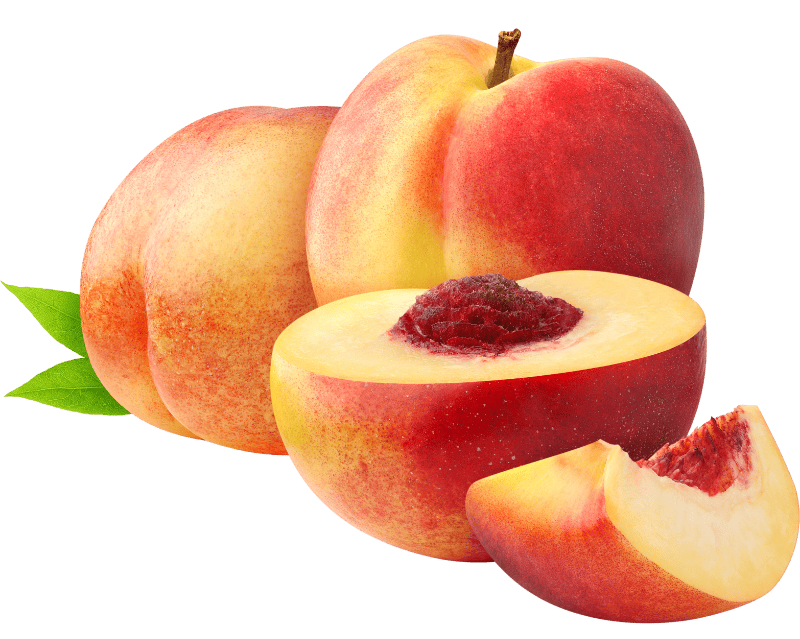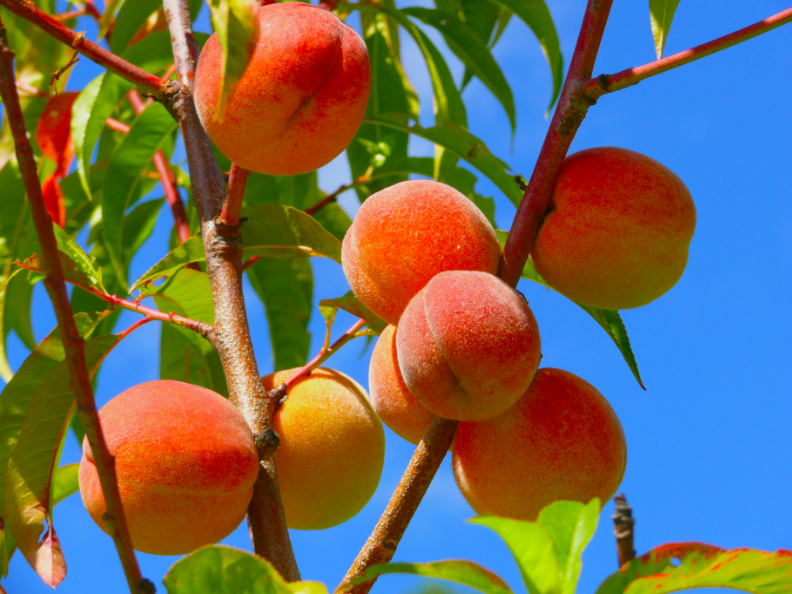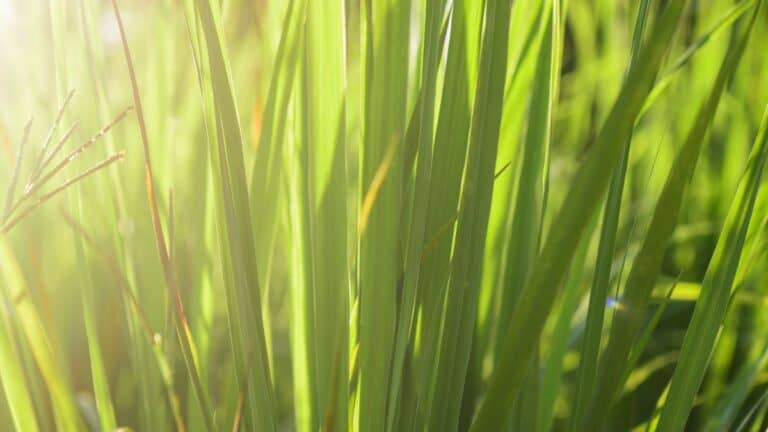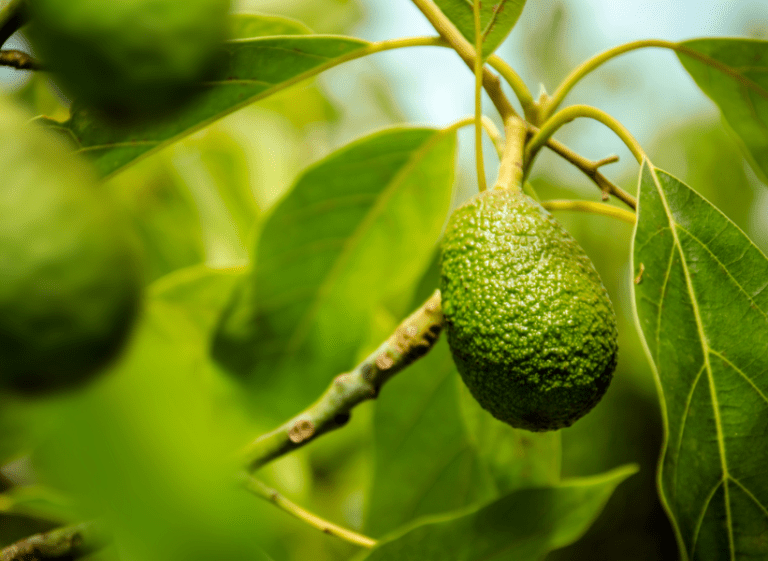How to Grow Peach Trees: A Comprehensive Guide and FAQs
How to Grow Peach Trees
If you’re wondering how to grow peach fruit trees, you’re in for an exciting journey. This comprehensive growing guide delves into how to grow a peach tree plant, care, propagation, fruiting, and much more.
Peach trees (Prunus persica) offer the home garden a delightful blend of lush foliage, fragrant flowers, and juicy fruits.

Generally speaking, peach trees that are grown from a young sapling (as opposed to from seed) will take approximately 2 to 4
From the Start – What is a Peach Tree?
A peach tree plant (Prunus persica) is a deciduous fruit tree native to China but extensively cultivated in various parts of the world, particularly in temperate climates. The tree is part of the Rosaceae family, which also includes other stone fruits like cherries and plums. Peach trees can grow up to 15–25 feet tall, although dwarf varieties that are suitable for small gardens or container cultivation may only reach heights of about 4–6 feet.
The tree has lanceolate leaves with serrated edges, which provide a vibrant green canopy. In early spring, the tree bursts into bloom, producing charming pink flowers that exude a light, sweet fragrance. These blossoms eventually give way to the juicy, fragrant fruit we commonly know as peaches. The fruit is typically round, with a soft, fuzzy skin and juicy, sweet flesh surrounding a hard pit or stone.
How Long Does It Take for a Peach Tree to Grow?
The Short Answer:
The time it takes for a peach tree to grow and bear fruit varies depending on several factors, including the variety of the tree, the planting method, and the growing conditions. Generally, it can take anywhere from 2 to 4 years for a peach tree to produce its first fruit after planting.
The Detailed Answer:
Factors Affecting Growth Time:
- Variety of Peach Tree: Different varieties mature at different rates. Early-maturing varieties might produce fruit sooner than late-maturing ones.
- Planting Method: Trees grown from seeds take longer to produce fruit, often 4-8 years, compared to 2-4 years for trees that are propagated from cuttings or bought as young trees.
- Growing Conditions: Soil quality, climate, and care can significantly impact how quickly a tree matures. Trees in optimal conditions will grow and produce fruit faster.
- Tree Health: Diseases and pests can slow down a tree’s growth and delay fruiting.
Timeline for a Peach Tree:
- Year 1: Planting and Establishment
- The first year is crucial for establishing the tree’s root system. You may not see significant above-ground growth, but the roots are busy establishing themselves.
- Year 2-3: Vegetative Growth
- The tree will focus on leaf and branch growth. By the end of this period, you may start to see some fruiting, particularly if you have a fast-maturing variety and optimal growing conditions.
- Year 4 Onward: Fruiting
- Most peach trees will reliably produce fruit from this point onward, assuming they are well-cared for.
Tips for Faster Growth:
- Proper Planting: Make sure you plant the peach tree in well-drained soil and in a location that receives at least 6 hours of direct sunlight daily.
- Regular Fertilization: A balanced fertilizer can help boost growth and fruit production.
- Pruning: Proper pruning helps to direct the tree’s energy into fruit production, rather than unnecessary leaf and branch growth.
- Pest and Disease Management: Regular inspections and treatments as necessary can keep the tree healthy, which in turn will help it grow and fruit more quickly.
- Watering: Consistent watering, especially during dry spells, will help speed up growth. However, avoid overwatering, as peach trees do not like “wet feet.”
By understanding these factors and timelines, you can better plan for when to expect fruit from your peach tree. Keep in mind that nature has its own timetable, and patience is key to successful peach tree cultivation.
Difference Between a Peach and a Nectarine
While both peaches and nectarines belong to the Prunus persica species, they are differentiated primarily by the texture of their skin.
Peach Fruit
- Skin Texture: Fuzzy or velvety skin that is soft to touch.
- Flavor: Generally sweeter and less acidic, although this can vary.
- Cultivars: Multiple types are available, including white-fleshed and yellow-fleshed varieties.
- Fruit Shape: May have a slightly more rounded shape.
Nectarine Fruit
- Skin Texture: Smooth, glossy skin with no fuzz.
- Flavor: Often more aromatic and might have a slightly stronger acidic bite.
- Cultivars: Similar to peaches, they come in white and yellow-fleshed varieties.
- Fruit Shape: May be slightly more elongated or come in a flatter shape, depending on the cultivar.
Despite these differences, the care for both types of fruit trees is largely the same. They are susceptible to similar pests and diseases and have similar requirements for soil, water, and climate. Moreover, because they are of the same species, a peach tree plant can sometimes produce nectarines, and vice versa, due to genetic mutations.
So, whether you’re a fan of the velvety touch of a peach or the smooth feel of a nectarine, both fruits offer delightful flavors and aromas, making them cherished staples in orchards and gardens around the world.
Grow Peach Trees Common Questions
How long does it take for a peach tree to bear fruit?
The time it takes for a peach tree to bear fruit can vary depending on several factors, such as the variety of the tree, the growing conditions, and how the tree was propagated. Generally speaking, peach trees that are grown from a young sapling (as opposed to from seed) will take approximately 2 to 4 years to produce fruit.
Factors Influencing Time to Fruition:
- Propagation Method: Trees grown from seeds can take several years longer to fruit, often requiring around 3 to 6 years. In contrast, those purchased as young saplings or as bare root trees are usually 1 to 2 years old already and may bear fruit within another 1 to 2 years.
- Tree Variety: Some fast-maturing peach tree varieties may bear fruit more quickly, while others may take a bit longer.
- Growing Conditions: Optimal growing conditions, including proper soil, adequate water, and the right climate, can significantly affect how quickly a tree matures and produces fruit.
- Tree Health: Healthy trees that are free from pests and diseases are more likely to bear fruit at a younger age.
- Pruning and Care: Properly pruned and well-cared-for trees are likely to bear fruit more quickly than neglected trees.
It’s worth noting that while the tree may produce fruit within this timeframe, the first couple of seasons’ yields are generally smaller, both in terms of fruit size and quantity. As the tree matures, it should produce more abundant and larger fruit.
Do you need 2 peach trees to produce fruit?
The short answer is no; you do not need two peach trees to produce fruit. The question of whether you need two peach fruit trees to produce fruit is a common one, especially among novice gardeners. Most peach tree varieties are self-fertile, meaning that a single tree has the capability to pollinate its own flowers. As a result, you can get a reasonable crop from just one tree.
However, there are benefits to having more than one tree:
Advantages of Multiple Peach Trees:
- Increased Pollination: While most peach trees are self-fertile, having a second tree can enhance pollination, resulting in better fruit set and potentially larger fruit.
- Extended Harvest: Different varieties of peach trees have different harvest times. Having multiple varieties can extend your peach season.
- Cross-Pollination for Unique Flavors: While not necessary for fruit production, having different peach tree varieties can result in interesting cross-pollinated fruit, though this is more of an experimental benefit.
- Backup: Having more than one tree provides some insurance against environmental stress, pests, and diseases that may affect one but not the other.
To sum it up, while a single peach tree is often sufficient for producing fruit, having more than one can offer benefits like extended harvest periods and increased pollination. If you have the space, planting more than one tree can be a rewarding experience.
Are Peach Trees Easy to Grow?
Peach trees are relatively easy to grow, especially for gardeners who are willing to put in a bit of effort to meet their basic care requirements. These trees are well-suited for temperate climates and, with proper care, can provide an abundant harvest of juicy peaches. However, like all fruit trees, they do have specific needs that must be met for optimal health and fruit production. Here are some key points to consider:
Advantages of Growing Peach Trees:
- Self-Fertile: Most peach trees are self-fertile, which means you don’t need more than one tree for pollination and fruit set.
- Variety: There are many varieties available that are suited for different climates, including dwarf varieties that are suitable for smaller spaces or even container gardening.
- Fast to Bear Fruit: Compared to other fruit trees like apple or pear, peach trees are relatively quick to produce fruit, often within 2 to 4 years of planting.
- Versatile in Culinary Uses: The fruit can be used in a variety of ways, from fresh eating to jams, jellies, and baking.
Challenges in Growing Peach Trees:
- Pests and Diseases: Peach trees need protection against pests are they are susceptible to several pests like aphids and diseases such as peach leaf curl, which can affect their health and reduce fruit yield.
- Climate Requirements: While they are somewhat adaptable, peach fruit trees need warm climates; they do best in temperate climates and may struggle or fail to produce fruit in regions that are too cold or too hot. They also require a certain number of chilling hours during the winter to produce fruit.
- Pruning: Regular pruning is essential for the tree’s health and to maximize fruit production, but improper pruning can harm the tree.
- Soil Needs: Prefer well drained, slightly acidic soil, which may require gardeners to amend their native soil for optimal growth.
- Fertilization: Regular fertilization is needed, but over-fertilization can lead to excessive foliage and reduced fruiting.
In summary, peach trees are relatively easy to grow if their specific care requirements are met. Gardeners who are willing to invest time in learning about peach tree care, including proper planting, watering, fertilization, and disease prevention, can expect a rewarding and fruitful experience.
Soil pH and Its Importance When Growing a Peach Tree
Soil pH is a critical factor that influences the health and productivity of peach trees. The pH level of the soil can affect nutrient availability, microbial activity, and the tree’s ability to absorb water and nutrients. Understanding the soil pH needs of peach trees and how to adjust your soil can make a significant difference in the success of your peach-growing venture.
Ideal Soil pH for Peach Trees:
- Optimal Range: Peach trees prefer a slightly acidic to neutral soil pH, ranging from 6.0 to 7.0.
- Tolerance Range: While they perform best in this range, peach trees are relatively tolerant and can also grow in soils with a pH range of 5.5 to 7.5.
Why Soil pH Matters:
- Nutrient Absorption: Certain essential nutrients like nitrogen, phosphorus, and potassium are more easily absorbed by peach trees when the soil pH is in the optimal range.
- Microbial Activity: Beneficial soil microbes that help break down organic matter and fix nitrogen are more active in slightly acidic to neutral soils.
- Disease Resistance: Proper soil pH can help peach trees better resist certain soil-borne diseases.
- Water Uptake: The pH level affects soil structure, which in turn affects the soil’s water-holding capacity and drainage, both crucial for peach tree growth.
How to Test and Adjust Soil pH:
- Testing: You can test the soil pH using a home soil test kit, or by sending a soil sample to a professional lab.
- Increasing pH (Making Soil More Alkaline): If your soil is too acidic, you can raise the pH by adding lime to the soil.
- Decreasing pH (Making Soil More Acidic): If the soil is too alkaline, you can lower the pH by incorporating elemental sulfur, aluminum sulfate, or iron sulfate.
- Organic Matter: Adding organic matter like compost can also help buffer soil pH and improve its overall structure.
- Retesting: After making adjustments, it’s advisable to retest the soil pH to ensure it is in the optimal range for peach tree growth.
- Consult Experts: If you’re unsure about how to adjust your soil pH, consider seeking advice from local agricultural extension services or experts.
In summary, maintaining the right soil pH is essential for growing healthy, productive peach trees. Regular testing and appropriate amendments can keep your soil within the ideal pH range, thereby maximizing your peach harvest.
Spacing Requirements for Planting Peach Trees
The spacing between peach trees is an important factor that can significantly impact the health of the trees and the quality of the fruit. Proper spacing allows for adequate air circulation, sunlight penetration, and ease of maintenance. Here are some general guidelines on how far peach trees should be planted from each other:
Standard Size Peach Trees:
- Row Spacing: For standard peach trees, the rows should be spaced about 18 to 20 feet apart.
- Within-Row Spacing: Within each row, standard peach trees should be planted about 15 to 20 feet apart from each other.
Dwarf Peach Trees:
- Row Spacing: Dwarf peach trees require less space. The rows can be spaced about 10 to 12 feet apart.
- Within-Row Spacing: Within each row, dwarf peach trees should be spaced about 8 to 10 feet apart.
Special Spacing Considerations:
- Soil and Fertility: If your soil is particularly fertile, you may want to increase the spacing slightly, as the trees may grow larger than expected.
- Irrigation Systems: If you plan to use an irrigation system, consider its layout when determining your spacing.
- Pruning: More aggressive pruning can allow for slightly closer spacing, but this requires more work to maintain.
- Interplanting: If you are interplanting with other types of trees or plants, additional spacing may be required.
Proper spacing is essential for optimal health and fruit production. It can help prevent the spread of diseases and allow for better air circulation, which dries the foliage and minimizes the risk of fungal infections. It also makes it easier to carry out maintenance tasks like pruning, thinning, and harvesting. Make sure to consider the variety and specific needs of your peach trees when determining the best spacing for your orchard or garden.
Sunlight Requirements for Young Peach Trees: Full Sun vs. Shade
One of the most crucial factors in the successful growth of young peach trees is the amount of sunlight they receive. Here’s what you need to know about the sunlight requirements for your young peach trees:
Full Sun is Ideal:
- Optimal Sunlight: Young peach trees thrive in full sun, which means they should receive at least 6 to 8 hours of direct sunlight per day.
- Fruit Production: Full sun exposure is essential for optimal fruit production. Trees that do not receive adequate sunlight will likely produce fewer, smaller, and less flavorful peaches.
- Healthy Growth: Sufficient sunlight also contributes to overall tree health by strengthening the branches and reducing susceptibility to diseases.
Drawbacks of Shade:
- Reduced Yield: Trees planted in shaded areas will have reduced fruit yield and may exhibit slower growth.
- Disease Risk: Lack of adequate sunlight can result in damp conditions, making the tree more susceptible to fungal diseases like peach leaf curl or bacterial infections.
- Poor Fruit Quality: Insufficient sunlight often leads to poor fruit coloration and reduced sugar content, affecting the taste and appearance of the peaches.
Considerations:
- Time of Day: Morning sun is particularly beneficial as it dries the dew on the leaves, reducing the likelihood of fungal diseases.
- Seasonal Changes: Keep in mind that the angle of the sun changes with the seasons, so a spot that is sunny in the summer may not be so in the spring or fall.
- Adjacent Plants: Be cautious about nearby trees or structures that might grow or be built and eventually block the sunlight your young peach tree receives.
- Temporary Shade: While it’s not ideal, young trees that are newly transplanted may benefit from a little shade or a sunshade cloth to protect them from extreme conditions like hot, direct afternoon sun, but this is generally only for a brief period right after planting.
Yung peach trees prefer full sun for healthy growth and fruitful yields. However, as they grow into mature trees, their root systems expand and their canopies thicken, which may create a microclimate around tree itself. Despite this, even mature trees benefit significantly from full sun exposure to ensure consistent and high-quality fruit production.
When planning your garden or orchard, keep in mind that even a one year old peach tree will need plenty of space to grow and should be situated in a location where it can receive at least 6 to 8 hours of direct sunlight. Make sure to clear any obstacles or potential sources of shade around the tree to ensure it gets adequate sun, both as a young sapling and as it matures.
By giving your young and mature peach trees the sunlight they need, you set the stage for years of bountiful harvests and robust tree health. Therefore, when selecting a planting site, make sure it offers enough sun exposure for your peach trees to thrive at any age.
How to Grow Peach Trees – Peach Tree Care
Planting
When it comes to planting peach trees, early spring is the best time. If you’re starting with a bare root tree, make sure to soak the tree roots in water for several hours before planting. Choose a sunny spot with well-drained soil for optimal growth. Dig a hole twice as wide as the root ball but just as deep.
How to Plant a Peach Tree:
- Remove weeds and grass from the planting area.
- Dig the hole.
- Place the tree in the hole and backfill with soil.
- Water thoroughly.
Watering
Peach trees need consistent watering, especially during dry periods. Over-watering can lead to root rot, while under-watering can stress the tree. Drip irrigation is generally considered the most efficient method.
Fertilization
Fertilize your peach trees in early spring when they start to bud. A balanced fertilizer with a ratio of 10-10-10 is generally recommended.
Fertilizing Peach Trees: Timing and Best Practices
When to Fertilize:
The optimal time to fertilize your peach trees is in early spring when the trees start to bud. This is the period when your peach trees awaken from their winter dormancy and begin a new cycle of growth and fruiting. Fertilizing at this time ensures that the trees receive essential nutrients just when they need it the most, which is crucial for fruit production and overall health.
Choosing the Right Fertilizer:
For peach trees, a balanced fertilizer with a ratio of 10-10-10 is generally recommended. This means the fertilizer contains 10% nitrogen (N), 10% phosphorous (P), and 10% potassium (K), which are the three primary nutrients required for plant growth.
- Nitrogen (N): Promotes leaf and shoot growth, which is important for photosynthesis.
- Phosphorus (P): Supports root development and flower formation, which is essential for fruiting.
- Potassium (K): Helps in overall plant health, including resistance to diseases and water regulation.
Check out our pick of top fertilizers here
How to Apply:
- Measure the Area: Before applying fertilizer, measure the area around the tree’s drip line, which is the ground area that corresponds to the spread of the tree’s branches.
- Calculate Quantity: Generally, you should apply about 1 pound of 10-10-10 fertilizer for each year of the tree’s age, up to a maximum of 10 pounds for mature trees.
- Application Method: Spread the fertilizer evenly around the base of the tree, starting about a foot away from the trunk and extending out to the drip line.
- Watering: After applying the fertilizer, water the area thoroughly to help the nutrients penetrate the soil and reach the roots.
Tips for Effective Fertilization:
- Soil Testing: It’s a good idea to test your soil every few years to check nutrient levels. This will help you determine if you need to adjust your fertilizer type or application rate.
- Alternate Sources: Organic matter like compost can be a great supplement to chemical fertilizers. It improves soil structure and provides a range of nutrients.
- Avoid Over-Fertilizing: Too much fertilizer can lead to excessive vegetative growth at the expense of fruit production. It can also make the tree more susceptible to diseases.
- Follow Manufacturer Guidelines: Always read and follow the guidelines provided by the fertilizer manufacturer for best results.
By understanding the importance of timing and choosing the right fertilizer, you can significantly improve the health and yield of your peach trees. Remember, the goal is to provide your trees with the nutrients they need to thrive, not just survive.
Pruning
Keep your peach trees pruned – Proper pruning is crucial for peach tree care. It allows light and air to reach the inner canopy, encouraging better fruit development. Always prune tree in late winter or early spring when the tree is dormant.
How to Prune Peach Trees:
- Remove dead or diseased branches.
- Cut back overly long branches.
- Thin out branches to allow light into the center of the tree.
Pest and Disease Protection
Common pests that afflict peach trees include aphids, peach borers, and scale. Diseases such as leaf curl and brown rot are also concerns. Regular inspections and timely application of appropriate pesticides or fungicides can help manage these issues.
Addressing Fungal Diseases in Peach Trees
One of the challenges that both young and mature peach trees may face is the threat of fungal diseases. These diseases can weaken the tree, reduce fruit yield, and in extreme cases, can even result in the loss of the tree. Here are some common fungal diseases that affect peach trees and how to manage them:
Common Fungal Diseases:
- Peach Leaf Curl: This is perhaps the most common fungal disease affecting peach trees. Leaves become distorted and discolored. Preventative treatment with fungicides is most effective when applied during the dormant season.
- Brown Rot: This affects the fruit itself, turning it brown and soft. The disease can spread rapidly, especially in wet conditions.
- Powdery Mildew: White powdery spots appear on leaves and fruit. Though not as damaging as other diseases, it can weaken the tree over time.
Prevention Measures:
- Full Sun: Adequate sunlight helps in drying the foliage quickly, reducing the chance of fungal spores settling on the tree.
- Proper Spacing: Ensure that trees are spaced properly for good air circulation around the tree, which helps in drying the leaves and reducing fungal growth.
- Cleanliness: Keep the area around the tree clean of fallen leaves, fruit, and other debris, which can harbor fungal spores.
- Watering: Use a soaker hose or drip irrigation to water the tree at its base rather than overhead watering, which can wet the leaves and promote fungal growth.
Treatment Options:
- Fungicides: Specific fungicides are available for different types of fungal diseases. It’s important to read the label and consult experts to make sure you’re using the right product at the right time.
- Pruning: Remove infected branches or leaves and dispose of them far from the tree to prevent the spread of the disease.
- Holistic Treatments: Some organic methods like neem oil sprays can be effective in treating mild fungal diseases.
- Regular Monitoring: Keep an eye on your peach trees, especially during wet seasons. Early detection can make treatment more effective.
Whether you’re dealing with young or mature peach trees, understanding the signs of fungal diseases and taking immediate steps for treatment is crucial. Regular monitoring, proper care, and early intervention can help keep your peach trees healthy and productive for years to come.
Peach Tree Propagation
If you’re looking to expand your peach orchard, propagation is a viable option. Peach trees can be propagated through seeds or softwood cuttings.
- From Seeds: Remove the pit from a ripe peach, clean it, and plant it in fertile soil. Germination usually occurs within several weeks.
- Softwood Cuttings: Take a cutting from a healthy branch, dip the end into rooting hormone, and plant it in a pot filled with moist soil.
Growing Dwarf Peach Trees
Dwarf peach trees are perfect for container gardening. They require similar care but are easier to manage due to their small size.
Peach Tree Fruiting
For fruitful yields, understanding chill hours, pollination, and thinning is crucial.
Peach Blossoms
Peach blossoms are usually pink and have a light, sweet fragrance. They typically appear in early spring.
- Chill Hours: Most peach trees require a certain number of chill hours—cold temperatures—to bear fruit. Check your selected variety for specific requirements.
- Pollination: While peach trees are self-fertile, having another tree can improve fruit set.
- Thinning: Thinning fruits early in the season can result in larger, healthier peaches.
Peach Tree Harvesting: When and How to Enjoy Your Peaches
Peach trees generally take 2-4 years to bear fruit. The peaches are ready when they are fully colored and slightly soft to the touch.
Harvesting peaches from your own peach tree can be one of the most rewarding experiences for a gardener. But how do you know when it’s the right time to pick, and are there any special tools that can enhance your peach-enjoying experience?
Timing is Everything:
- Softness: A ripe peach will yield slightly to gentle pressure when squeezed.
- Color: Look for a uniform color with no green around the stem; a ripe peach will typically have a deep yellow or peachy hue.
- Smell: A ripe peach will give off a sweet, aromatic scent, signaling that it’s ready to be picked.
- Taste Test: When in doubt, pick one peach and taste it. If it’s sweet and juicy, it’s likely the rest are ready or nearly so.
Tools for Harvest:
While you don’t necessarily need special tools to pick peaches, some gadgets can make the experience more enjoyable and efficient:
- Fruit Pickers: These long-handled tools with a small basket at the end can help you reach high branches without the need for a ladder.
- Pruning Shears: For branches that are hard to reach or for peaches that don’t easily twist off, a pair of sharp pruning shears can be useful.
- Soft Gloves: Some people like to wear soft gloves to avoid bruising the delicate fruit.
Special Tools for Enjoyment:
Once you’ve harvested your peaches, you might consider these tools to make enjoying them even more special:
- Peach Pitter/Slicer: This tool cores and slices the peach in one motion, making it easy to serve and eat.
- Juice Catcher: Ripe peaches can be juicy! A juice catcher or even a simple plate can help manage the delicious but sticky juice.
- Blender or Food Processor: For those interested in making peach smoothies, ice cream, or jams, a good blender or food processor can be a handy tool.
Harvesting peaches is an exciting time, marking the culmination of months of care and attention to your peach trees. With the right timing and optional special tools, you can enjoy the most delicious and satisfying fruit your tree has to offer.
Peach Tree Problems
Excessive Foliage: Over-fertilizing can cause excessive foliage at the expense of fruit.
Yellowing Veins: A sign of iron deficiency, treatable with iron chelates.
Holes in Leaves: Could be due to insect damage. Use appropriate pesticide.
Fruit Drop: Often caused by inadequate pollination or water stress.
Interesting Facts About Peach Trees
- Origin: Peach trees are originally from China.
- Relation to Nectarines: Peaches and nectarines are the same species; the difference is only skin-deep.
- Self-Fertility: Peach trees are generally self-fertile, which means a single tree can produce fruit.
FAQs
Generally, 2-4 years.
No, but having more than one can improve yields.
With proper care, yes.
rom a seed, approximately 3-6 years for fruiting.
Yes, although the fruit quality can vary.
They prefer temperate climates with well-drained soil.
Conclusion
Growing peach trees can be a rewarding experience, offering both aesthetic beauty and delicious fruits. With proper care and attention, you can cultivate a healthy, fruitful tree that will provide for years to come. Happy gardening!



